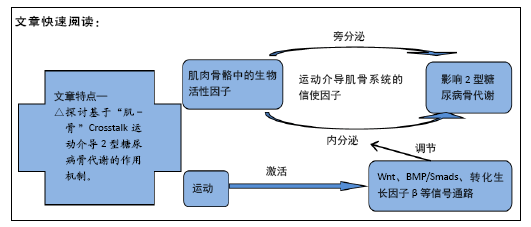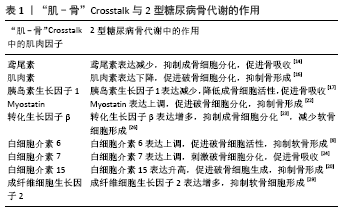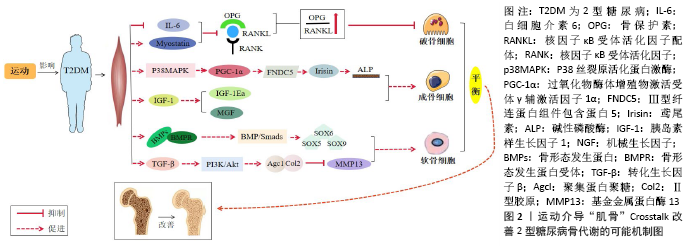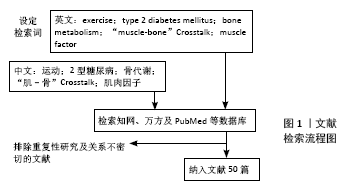[1] MATHIEU C. Developments in the management of type 1 and type 2 diabetes. Eur Endocrinol. 2018;14(2):13-14.
[2] HERMANS MP, AMOUSSOU GKD, BOUENIZABILA E, et al. Size, density and cholesterol load of HDL predict microangiopathy,coronary artery disease and β-cell function in men with T2DM. Diabetes Metab Syndr. 2017;11: 125-131.
[3] 江洪. 不同运动强度干预2型糖尿病模型大鼠的骨密度变化[J].中国组织工程研究,2016,20(27):3963-3969.
[4] 陈祥和. 不同方式运动对II糖尿病小鼠骨代谢的影响及分子机制研究[D]. 上海:华东师范大学,2016.
[5] 方幸, 李世昌, 徐帅. 肌肉因子与运动对骨骼的作用[J]. 中国体育科技, 2017,53(6):71-78.
[6] LI G, ZHANG L, ZHANG L, et al. Muscle-bone crosstalk and potential therapies for sarco-osteoporosis. J Cell Biochem. 2019;120(9):14262-14273.
[7] 黄宏兴, 吴青, 李跃华, 等. 肌肉、骨骼与骨质疏松专家共识[J]. 中国骨质疏松杂志,2016,22(10):1221-1229+1236.
[8] MIHARA M, HASHIZUME M, YOSHIDA H, et al. IL-6/IL-6 receptor system and its role in physiological and pathological conditions. Clin Sci (Lond). 2012; 122(4):143-159.
[9] BAKKER AD, JASPERS RT. IL-6 and IGF-1 signaling within and between muscle and bone: how important is the mTOR pathway for bone metabolism?. Curr Osteoporos Rep. 2015;13(3):131-139.
[10] GONG W, LIU Y, WU Z, et al. Meteorin-like shows unique expression pattern in bone and its overexpression inhibits osteoblast differentiation. PLoS One. 2016;11(10):e0164446.
[11] ERJAVEC I, BORDUKALO NT, BRKLJACIC J, et al. Constitutively elevated blood serotonin is as sociated with bone loss and type 2diabetes in rats. PLoS One. 2016;11(2):e0150102.
[12] HUYBRECHTS Y, MORTIER G, BOUDIN E, et al. WNT Signaling and Bone: Lessons From Skeletal Dysplasias and Disorders. Front Endocrinol (Lausanne). 2020;11:165.
[13] KWON JH, MOON KM, MIN KW. Exercise-Induced Myokines can Explain the Importance of Physical Activity in the Elderly: An Overview. Healthcare (Basel). 2020;8(4):378.
[14] 王贺, 王莲地, 阳琰, 等. 2型糖尿病合并骨质疏松患者血清25羟维生素D、鸢尾素水平观察及其与骨密度的关系[J]. 中国糖尿病杂志,2018, 26(7):569-572.
[15] WEI XF, CHEN QL, FU Y, et al. Wnt and BMP signaling pathways co-operatively induce the differentiation of multiple myeloma mesenchymal stem cells into osteoblasts by upregulating EMX2. J Cell Biochem. 2019; 120(4):6515-6527.
[16] BIKLE DD, TAHIMIC C, CHANG W, et al. Role of IGF-I signaling in muscle bone interactions. Bone. 2015;80:79-88.
[17] 陆鹏程, 陈祥和, 杨康, 等. 自噬介导运动改善2型糖尿病骨代谢紊乱的作用机制[J].中国组织工程研究,2020,24(20):3256-3262.
[18] CHEN WJ, LIU Y, SUI YB, et al. Increased circulating levels of musclin in newly diagnosed type 2 diabetic patients. Diab Vasc Dis Res. 2017;14(2):116-121.
[19] Willems WF, Larsen M, Friedrich PF, et al. Induction of angiogenesis and osteogenesis in surgically revascularized frozen bone allografts by sustained delivery of FGF-2 and VEGF. J Orthop Res. 2012;30(10):1556-1562.
[20] RATHINAVELU S, RATHINAVELU S, BANU J. Molecular modulation of osteoblasts and osteoclasts in type 2 diabetes. J Diabetes Res. 2018:6354787.
[21] 马涛, 李世昌. 上、下坡跑台运动对去卵巢小鼠破骨细胞分化NF-κB信号通路的影响[J]. 中国运动医学杂志,2015,34(5):468-474.
[22] DANKBAR B, FENNEN M, BRUNERT D, et al. Myostatin is a direct regulator of osteoclast differentiation and its inhibition reduces inflammatory joint destruction in mice. Nat Med. 2015; 21(9):1085-1090.
[23] 鲍晓雪, 王娜, 李玉坤, 等. 血清OPG、TGF-β和IL-6水平对绝经后骨量减少合并2型糖尿病患者骨折风险的预测[J]. 中华老年骨科与康复电子杂志,2018,4(1):9-13.
[24] AMARASEKARA DS, YUN H, KIM S, et al. Regulation of Osteoclast Differentiation by Cytokine Networks. Immune Netw. 2018;18(1):e8.
[24] CHOI MC, JO J, PARK J, et al. NF-κB signaling pathways in osteoarthritic cartilage destruction. Cells. 2019;8(7):734.
[25] 刘波, 陈祥和, 杨康, 等. DNA甲基化在运动干预骨质疏松中的作用机制[J].中国组织工程研究,2021,25(5):791-797.
[26] CANNATA F, VADALÀ G, Ambrosio L, et al. Osteoarthritis and type 2 diabetes: From pathogenetic factors to therapeutic intervention. Diabetes Metab Res Rev. 2020;36(3):e3254.
[27] BLANEY DEN, SCHARSTUHL A, VINERS EL, et al. Reduce IX1 transforming growth factor-bets signaling in cartilge of old mice:role in impaired repair capadty. Arthritis Res Ther. 2005;7(6):R1338-1347.
[28] WANG Z, SUN J, LI Y, et al. Experimental study of the synergistic effect and network regulation mechanisms of an applied combination of BMP-2, VEGF, and TGF-β1 on osteogenic differentiation.J Cell Biochem. 2020;121(3): 2394-2405.
[29] HUANG H, LUO L, LIU Z, et al. Role of TNF-α and FGF-2 in the fracture healing disorder of type 2 diabetes model induced by high fat diet followed by streptozotocin. Diabetes Metab Syndr Obes. 2020;13:2279-2288.
[30] CHEN X, LI L, GUO J, et al. Treadmill running exercise prevents senile osteoporosis and upregulates the Wnt signaling pathway in SAMP6 mice. Oncotarget. 2016;7(44):71072-71086.
[31] KLENTROU P, ANGRISH K, AWADIA N, et al. Wnt signalingrelated osteokines at rest and following plyometric exercise in prepubertal and early pubertal boys and girls. Pediatr Exerc Sci. 2018;30(4):457-465.
[32] CHENG L, KHALAF A T, LIN T, et al.Exercise promotes the osteoinduction of HA/β-TCP biomaterials via the Wnt signaling pathway. Metabolites. 2020;10(3):E90.
[33] Bullock WA, Pavalko FM, Robling AG. Osteocytes and mechanical loading:The Wnt connection. Orthod Craniofac Res. 2019;22(1):175-179.
[34] ZHANG J, VALVERDE P, ZHU X, et al. Exercise-induced irisin in bone and systemic irisin administration reveal new regulatory mechanisms of bone metabolism. Bone Res. 2017;5:16056.
[35] 李广周, 吴伟. 运动对MSCs向成骨细胞分化相关信号通路的影响[J]. 中国细胞生物学学报,2016,38(8):1031-1035.
[36] KANAZAWA I, NOTSU M, MIYAKE H, et al. Assessment using serum insulin-like growth factor-I and bone mineral density is useful for detecting prevalent vertebral fractures in patients with type 2 diabetes mellitus. Osteoporos Int. 2018;29(11):2527-2535.
[37] 方幸. 运动介导肌肉因子IGF-1、FGF-2对小鼠骨的影响[D].上海:华东师范大学,2018.
[38] MARAHLEH A, KITAURA H, OHORI F, et al. TNF-α Directly Enhances Osteocyte RANKL Expression and Promotes Osteoclast Formation. Front Immunol. 2019;10:2925.
[39] 陈祥和, 李世昌, 孙朋, 等. 游泳和下坡跑通过CN/NFAT信号途径对2型糖尿病小鼠吸收代谢的影响[J]. 中国体育科技,2018,54(4):113-119+145.
[40] TOBEIHA M, MOGHADASIAN MH, AMIN N, et al. RANKL/RANK/OPG Pathway: A Mechanism Involved in Exercise-Induced Bone Remodeling. Biomed Res Int. 2020:6910312.
[41] MESINOVIC J, ZENGIN A, DE CB, et al. Sarcopenia and type 2 diabetes mellitus: a bidirectional relationship. Diabetes Metab Syndr Obes. 2019;12: 1057-1072.
[42] KABAK B, BELVIRANLI M, OKUDAN N. Irisin and myostatin responses to acute high-intensity interval exercise in humans. Horm Mol Biol Clin Investig. 2018;35(3):/j/hmbci.
[43] KONOPKA AR, WOLFF CA, SUER MK, et al. Relationship between intermuscular adipose tissue infiltration and myostatin before and after aerobic exercise training. Am J Physiol Regul Integr Comp Physiol. 2018; 315(3):R461-R468.
[44] MOTAHARI RAD M, BIJEH N, ATTARZADEH HOSSEINI SR, et al. The effect of two concurrent exercise modalities on serum concentrations of FGF21, irisin, follistatin, and myostatin in men with type 2 diabetes mellitus. Arch Physiol Biochem. 2020;1-10.
[45] CHEN X, SUN X, WANG C, et al. Effects of Exercise on Inflammatory Cytokines in Patients with Type 2 Diabetes: A Meta-analysis of Randomized Controlled Trials. Oxid Med Cell Longev. 2020;2020:6660557.
[46] KWON JH, MOON KM, MIN KW. Exercise-Induced Myokines can Explain the Importance of Physical Activity in the Elderly: An Overview. Healthcare (Basel). 2020;8(4):378.
[47] BULLOCK WA, PAVALKO FM, ROBLING AG. Osteocytes and mechanical loading:The Wnt connection. Orthod Craniofac Res. 2019;22(Suppl 1):175-179.
[48] LE H, XU W, ZHUANG X, et al. Mesenchymal stem cells for cartilage regeneration. J Tissue Eng. 2020;11:2041731420943839.
[49] SUN K, LUO J, GUO J, et al. The PI3K/AKT/mTOR signaling pathway in osteoarthritis: a narrative review. Osteoarthritis Cartilage. 2020;28(4):400-409.
[50] ZAMFIROV K, PHILIPPE J. Manifestations musculosquelettiques du diabète sucré : une complication fréquente Musculoskeletal complications in diabetes mellitus. Rev Med Suisse. 2017;13(560):917-921. |



